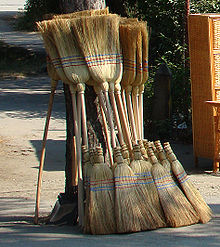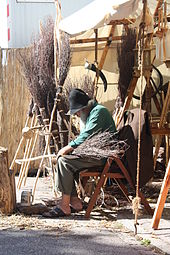
A broom (also known as a broomstick) is a cleaning tool consisting of usually stiff fibers (often made of materials such as plastic, hair, or corn husks) attached to, and roughly parallel to, a cylindrical handle, the broomstick. It is thus a variety of brush with a long handle. It is commonly used in combination with a dustpan.
A distinction is made between a "hard broom" and a "soft broom" and a spectrum in between. Soft brooms are used in some cultures chiefly for sweeping walls of cobwebs and spiders, like a "feather duster", while hard brooms are for rougher tasks like sweeping dirt off sidewalks or concrete floors, or even smoothing and texturing wet concrete. The majority of brooms are somewhere in between, suitable for sweeping the floors of homes and businesses, soft enough to be flexible and to move even light dust, but stiff enough to achieve a firm sweeping action.[citation needed]
The broom is also a symbolic object associated with witchcraft and ceremonial magic.
The word "broom" derives from the name of certain thorny shrubs (Genista and others) used for sweeping.[1] The name of the shrubs began to be used for the household implement in Late Middle English and gradually replaced the earlier besom during the Early Modern English period. The song Buy Broom Buzzems (by William Purvis 1752–1832) still refers to the "broom besom" as one type of besom (i.e. "a besom made from broom").
Flat brooms, made of broom corn,[2] were invented by Shakers in the 19th century with the invention of the broom vice.[3] A smaller whisk broom or brush is sometimes called a duster.
|
See also: Shaker broom vise |

In 1797, the quality of brooms changed when Levi Dickenson, a farmer in Hadley, Massachusetts, made a broom for his wife, using the tassels of sorghum, a grain he was growing for the seeds. His wife spread good words around town, creating demand for Dickenson's sorghum brooms. The sorghum brooms held up well, but ultimately, like all brooms, fell apart. Dickenson subsequently invented a machine that would make better brooms, and faster than he could. In 1810, the foot treadle broom machine was invented. This machine played an integral part in the Industrial Revolution.[4]
One source mentions that the United States had 303 broom factories by 1839 and that the number peaked at 1,039 in 1919. Most of these were in the Eastern United States; during the Great Depression in the 1930s, the number of factories declined to 320 in 1939.[5] The state of Oklahoma became a major center for broom production because broom corn grew especially well there, with The Oklahoma Broom Corn Company opening a factory in El Reno in 1906. Faced with competition from imported brooms and synthetic bristles, most of the factories closed by the 1960s.[5]

In the context of witchcraft, broomstick is likely to refer to the broom as a whole, known as a besom. The first known reference to witches flying on broomsticks dates to the 11th-century Islamic traditionalist theologian Ibn Qudamahin his book al-Mughnī ( The Persuader ). The first reference to witches flying on broomsticks in Europe dates to 1453, confessed by the male witch Guillaume Edelin.[6] The concept of a flying ointment used by witches appears at about the same time, recorded in 1456.
In Metro-Goldwyn-Mayer's 1939 film, The Wizard of Oz, the Wicked Witch of the West used a broomstick to fly over Oz. She also used it to skywrite "Surrender Dorothy" above the Emerald City. The Wizard commands Dorothy and her three traveling companions to bring the Wicked Witch's broomstick to him in order to grant their wishes. Dorothy carries it to the Wizard with the Scarecrow, Tin Man, and Lion after the Wicked Witch's death.
In Disney's 1940 film Fantasia, Mickey Mouse, playing The Sorcerer's Apprentice, brings a broom to life to do his chore of filling a well full of water. The broom overdoes its job and when chopped into pieces, each splinter becomes a new broom that flood the room until Yen Sid stops them. This story comes from a poem by Goethe called Der Zauberlehrling ("The Sorcerer's Apprentice"). The Disney brooms have had recurring cameos in Disney media, mostly portrayed as janitors, albeit not out of control or causing chaos such as in the original appearance.
This flight was also in Bedknobs and Broomsticks as well as Hocus Pocus.
In Eswatini (Swaziland), witches' broomsticks are short bundles of sticks tied together without a handle.[7]
Flying brooms play an important role in the fantasy world of Harry Potter, used for transportation as well as for playing the popular airborne game of Quidditch. Flying brooms, along with Flying carpets, are the main means of transportation in the world of Poul Anderson's Operation Chaos.
The Flying Broom (Turkish: Uçan Süpürge) is a feminist organization in Turkey, deliberately evoking the associations of a Flying Broom with witches.
But a Broom-Stick, perhaps you will say, is an Emblem of a Tree standing on its Head; and pray what is Man, but a Topsy-turvey Creature, his Animal Faculties perpetually mounted on his Rational; His Head where his Heels should be, groveling on the Earth, and yet with all his Faults, he sets up to be an universal Reformer and Corrector of Abuses, a Remover of Grievances, rakes into every Sluts Corner of Nature, bringing hidden Corruptions to the Light, and raises a mighty Dust where there was none before, sharing deeply all the while, in the very same Pollutions he pretends to sweep away: His last Days are spent in Slavery to Women, and generally the least deserving; till worn to the Stumps, like his Brother Bezom, he is either kickt out of Doors, or made use of to kindle Flames, for others to warm themselves by.[15]

For much of the 20th century, political cartoons and propaganda would often depict new or oncoming leaders sweeping away old, corrupt or unpopular figures.
The broom is used as a symbol of the following political parties: